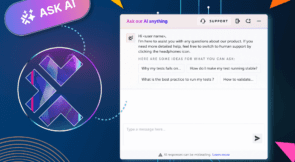Automated testing tools have been around for ages. Solutions like Selenium, Silk Test, and QTP have been helping developers and annoying them in almost equal parts. But now, we’re at the point where artificial intelligence (AI) has become more viable. (If you’re not sure what I mean by AI, think of it as the ability for a computer to learn and adapt based on data, rather than human intervention, such as re-coding.)
As a result, AI testing tools are gaining momentum. However, it can be hard to keep up with the rapid changes. Especially when you’re making decisions about something as vital as software testing.
So if you’re looking at your current DevOps process, wondering how you’re going to improve your tests without increasing the the time you take to complete them? You’ve come to the right place.
In this post, I’ll first give a bit of an intro to AI testing tools. This isn’t designed to tell you everything you need to know, but it’s a crash course so you can understand the concepts.
After that, I’ll introduce three tools that you should get to know. These tools are mature enough that they’re stable, while also still pushing the boundaries of AI testing. Each of the tools addresses a different facet of testing. Therefore, you can use them independently or together.
What Are AI Testing Tools?
As I said above, AI has become more viable in recent years. This is a result of a few technical advancements converging. AI algorithms have been suggested in mathematical terms since the early 1950s. However, to be feasible they required more computing power and data than was available at the time.
We’re at a point now where the data is available and computing is powerful enough. So what does this mean with respect to AI testing tools?
Connecting the dots, AI testing tools use data and algorithms to design and perform tests without human intervention. For example, some of these tools can perform actions such as authoring, updating, and maintaining tests without a human having to go in and define the changes. The purpose is to allow developers to spend less time testing so they can meet the increased demands of a continuous release cycle.
With that rapid-fire introduction to AI testing tools, I hope you’ve got a bit of an understanding of what they are. If not, the following tools may help to clarify, or you can look at this more detailed introduction.
Three Tools You Should Get to Know
In this section, I’ll introduce three tools that you should know about. Each of these targets a different type of AI testing.
Testim: Functional Testing
Testim is all about “Automated Functional Testing.” It’s designed to be a platform that supports the spectrum of automated testing tasks. These include authoring, maintaining, troubleshooting, reporting, and executing tests.
In a nutshell, Testim’s platform aims to improve the stability, scalability, and resilience of tests you create. Also, it makes it faster for you to write and maintain the tests.
This starts by providing methods to write tests through code or in a codeless UI setting. Then you’d bring in AI for test maintenance with the concept of Smart Locators. These track elements in the code so that the tests are robust to feature updates, refactoring, and other modifications.
You can speed up the execution of the tests with parallelization on a scalable test cloud that has advanced root cause analysis tools.
Finally, the platform generates reports. These contain all the information developers need.
What separates Testim from similar platforms is how their tests are quick to author and then super stable. The team wants to make testing so simple that anyone in an organization, not just the developers, can perform tests. This means that more stakeholders of a software product can participate in creating tests to increase test coverage. The tests use the Smart Locators to keep them stable even when code changes. Not only does that reduce the burden on developers, but it also increases the likelihood that the team will test for all eventualities.
If you’re interested in trying out the platform, you can get a free account here. There’s also a tutorial on how to get started here.
Sauce Labs: Continuous Testing
Next up, the people at Sauce Labs describe their organization as a platform for “Cross-Browser Testing, Selenium Testing, Mobile Testing.” They were an early entrant to cloud-based test automation and therefore have an abundance of data available.
By calling themselves a continuous testing platform, Sauce Labs wants to fit in at every stage of your DevOps pipeline. They aim to accelerate release cycles and reduce the number of bugs reported during production. Of course, this saves time and money. The original creator of Selenium founded the platform. You can almost think of it as a natural progression, bringing Selenium into the world of continuous development.
Where Sauce Labs is looking to use AI (primarily) is in improving the quality of tests. They want to use AI on their huge data to automatically generate useful tests and to determine the quality or impact of tests. That is, AI can weed out tests that are no longer useful, highlight tests that are likely to find bugs, or note when tests aren’t comprehensive enough.
If you want to put the history of Sauce Labs data behind your tests, have a look at the platform here.
Applitools: Visual Testing
Finally, Applitools says it’s “AI-Powered Visual UI Testing and Monitoring.” Their focus is on your app’s user interface and the various forms it takes.
Applitools designed the platform to sit on top of your existing tests rather than introducing a new testing language. Applitools’ Visual AI emulates “the human eye and brain…[to] only report differences that are perceptible to users and reliably ignore invisible rendering, size, and position differences.” This includes testing across multiple devices that may have different screen sizes or shapes. Their visual approach continues onto displaying test reports, with the platform analyzing the similarities and differences so that only distinct outcomes are displayed.
Applitools works through a roughly three-step process. You first need to augment your existing tests with visual assertions that the company provides software development kits for. The AI-based computer vision algorithms then go to work comparing expectation versus reality on different platforms and devices. The platform then generates test reports containing only distinct outcomes. Finally, you can integrate the tests into your release cycle so they run automatically every time.
By focusing on this niche, Applitools has set itself apart. The goal is to integrate with your existing tests, improving your UI in ways that other platforms can’t. Applitools gets over the hurdles that non-AI approaches face, such as minor pixel-level differences between browsers. This allows you to hone in on the important bugs.
If you have a user interface that needs another look, check out the Applitools product here.
A Quick Note on Integrating
If you’re looking to use the tools together, Testim and Applitools integrate their solutions natively, with many businesses using both. You can then use Sauce Labs as a grid for running tests built in Testim, embedding them in your DevOps cycle. In this way, you can start by building your core tests in Testim and then work outward.
Summing Up
AI testing tools are emerging as the future of software testing. It seems like every week there’s a new platform emerging that claims to be the next frontier. Keeping up can be exhausting. This post introduced three AI testing tools that you should get to know: Testim, Sauce Labs, and Applitools. Hopefully, this simplifies the process of keeping up. All the platforms use AI in unique ways that aim to simplify processes and improve outcomes.



